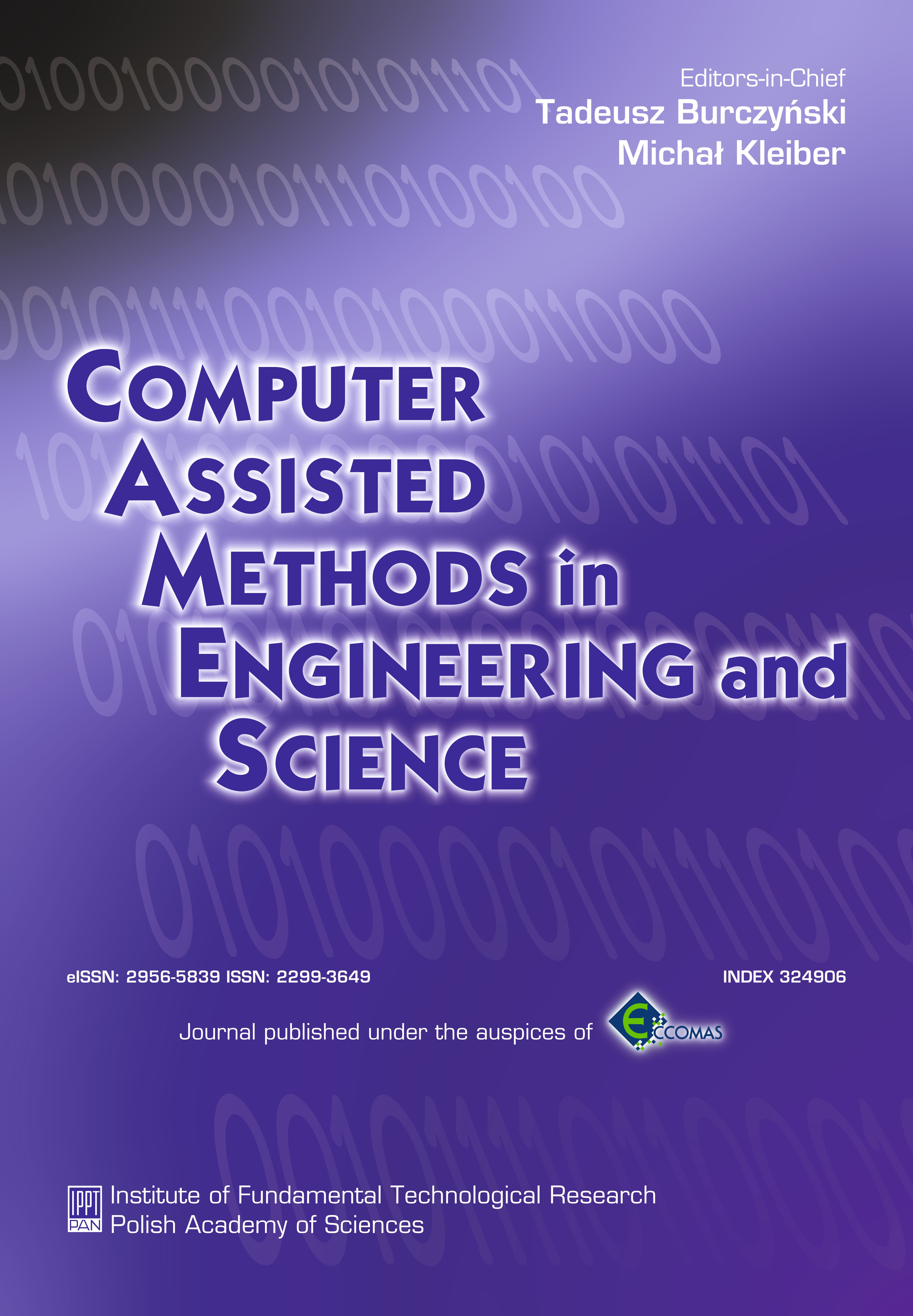Application of the Finite Pointset Method to Numerical Modeling of Heat Transferin Two-dimensional Tissue Subjected to a Moving Laser Beam
Abstract
In this article, a numerical analysis of thermal processes occurring in biological tissue during laser irradiation is presented. The mathematical model is based on the two-dimensional Pennes equation. The analyzed tissue is exposed to the laser irradiation of a moving beam with constant velocity along the tissue surface. The upper face of the skin tissue is subjected to the vertical laser beam, and it is assumed that heat dissipation through convection and radiation from the surface is negligible compared to the heat delivered by the laser beam. Thus, the surface is treated as thermally insulated surface. The effect of the laser beam’s transitional speed and power on the temperature distribution within the skin tissue are investigated. Moreover, the perfusion rate and the effective scattering coefficient are treated as variables dependent on tissue damage. In the computational part of this study, the finite pointset method (FPM) is applied. The temperature distribution computed with FPM is compared with an analytical one obtained for a three-dimensional problem by analyzing a relevant cross-section under the same conditions. This modeling of the dynamic thermal processes within biological tissue subjected to laser irradiation supports the evaluation of biological tissue damage and provides a basis for determining the time and intensity of laser irradiation. In the last part of the article, numerical examples and conclusions are presented.
Keywords:
finite pointset method, meshless methods, laser irradiation, moving laser beam, Pennes equationReferences
1. R. Verma, S. Kumar, Computational study on 2D three-phase lag bioheat model during cryosurgery using RBF meshfree method, Journal of Thermal Biology, 114: 103575, 2023, https://doi.org/10.1016/j.jtherbio.2023.103575.
2. H.H. Pennes, Analysis of tissue and arterial blood temperatures in the resting human forearm, Journal of Applied Physiology, 1(2): 93–122, 1948.
3. F. Xu, K.A. Seffen, T.J. Lu, Non-Fourier analysis of skin biothermomechanics, International Journal of Heat and Mass Transfer, 51(9–10): 2237–2259, 2008, https://doi.org/10.1016/j.ijheatmasstransfer.2007.10.024.
4. A.D. Hobiny, I.A. Abbas, Nonlinear analysis of dual-phase lag bio-heat model in living tissues induced by laser irradiation, Journal of Thermal Stresses, 43(4): 503–511, 2020, https://doi.org/10.1080/01495739.2020.1722050.
5. H. Askarizadeh, H. Ahmadikia, Analytical study on the transient heating of a two-dimensional skin tissue using parabolic and hyperbolic bioheat transfer equations, Applied Mathematical Modelling, 39(13): 3704–3720, 2015, https://doi.org/10.1016/j.apm.2014.12.003.
6. B. Partovi, H. Ahmadikia, M. Mosharaf-Dehkordi, Analytical and numerical analysis of the dual-pulse lag heat transfer in a three-dimensional tissue subjected to a moving multi-point laser beam, Journal of Thermal Biology, 112: 103431, 2023, https://doi.org/10.1016/j.jtherbio.2022.103431.
7. R.K. Chaudhary, I.A. Abbas, J. Singh, Numerical simulation of thermal response for non-linear multi-layer skin model subjected to heating and cooling, Thermal Science and Engineering Progress, 40, 2023, https://doi.org/10.1016/j.tsep.2023.101790.
8. M. Jasiński, Modelling of thermal damage in laser irradiated tissue, Journal of Applied Mathematics and Computational Mechanics, 14(4): 67–78, 2015, https://doi.org/10.17512/jamcm.2015.4.07.
9. F.R. Saucedo-Zendejo, E.O. Reséndiz-Flores, A new approach for the numerical simulation of free surface incompressible flows using a meshfree method, Computer Methods in Applied Mechanics and Engineering, 324: 619–639, 2017, https://doi.org/10.1016/j.cma.2017.06.027.
10. A. Wawreńczuk, J. Kuhnert, N. Siedow, FPM computations of glass cooling with radiation, Computer Methods in Applied Mechanics and Engineering, 196(45–48): 4656–4671, 2007, https://doi.org/10.1016/j.cma.2007.05.025.
11. E.O. Reséndiz-Flores, F.R. Saucedo-Zendejo, Numerical simulation of coupled fluid flow and heat transfer with phase change using the Finite Pointset Method, International Journal of Thermal Sciences, 133: 13–21, 2018, https://doi.org/10.1016/j.ijthermalsci.2018.07.008.
12. F.R. Saucedo-Zendejo, E.O. Reséndiz-Flores, Meshfree numerical approach based on the Finite Pointset Method for static linear elasticity problems, Computer Methods in Applied Mechanics and Engineering, 372, 2020, https://doi.org/10.1016/j.cma.2020.113367.
13. P.K. Gupta, J. Singh, K.N. Rai, S.K. Rai, Solution of the heat transfer problem in tissues during hyperthermia by finite difference-decomposition method, Applied Mathematics and Computation, 219(12): pp. 6882–6892, 2013, https://doi.org/10.1016/j.amc.2013.01.020.
14. T.N. Glenn, S. Rastegar, S.L. Jacques, Finite element analysis of temperature controlled coagulation in laser irradiated tissue, IEEE Transactions on Biomedical Engineering, 43(1): 79, 1996, https://doi.org/10.1109/10.477703.
15. J.P. Abraham, E.M. Sparrow, A thermal-ablation bioheat model including liquid-to-vapor phase change, pressure- and necrosis-dependent perfusion, and moisture-dependent properties, International Journal of Heat and Mass Transfer, 50: 2537–2544, 2007, https://doi.org/10.1016/j.ijheatmasstransfer.2006.11.045.
16. S. Tiwari, J. Kuhnert, Grid free method for solving the Poisson equation, Berichte des Fraunhofer ITWM, No. 25, Fraunhofer Institut für Techno- und Wirtschaftsmathematik, Kaiserslautern, 2001.
17. L.J.T. Doss, N. Kousalya, Finite Pointset Method for biharmonic equations, Computers and Mathematics with Applications, 75(10): 3756–3785, 2018, https://doi.org/10.1016/j.camwa.2018.02.029.
18. J. Kuhnert, General Smoothed Particle Hydrodynamics, Ph.D. Thesis, Technische Universität Kaiserslautern, 1999.
19. E.O. Reséndiz-Flores, I.D. García-Calvillo, Application of the finite pointset method to non-stationary heat conduction problems, International Journal of Heat and Mass Transfer, 71: 720–723, 2014, https://doi.org/10.1016/j.ijheatmasstransfer.2013.12.077.
20. M. Jasiński, Numerical modeling of tissue coagulation during laser irradiation controlled by surface temperature, Scientific Research of the Institute of Mathematics and Computer Science, 9(1): 29–36, 2010.







